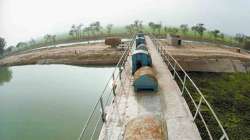With AAP in Punjab, what will happen to Sutlej-Yamuna Link canal row?
Of the multiple states in northwest India, Punjab, Haryana, Rajasthan, Delhi and some part of Uttar Pradesh share the same water infrastructure and are regulated by two bodies and agreements:

Though it is a decades old problem, the Sutlej-Yamuna Link Canal (SYL) issue has been simmering with renewed rigour since July 2020 when the Supreme Court asked Punjab and Haryana to settle the matter.
Of the multiple states in northwest India, Punjab, Haryana, Rajasthan, Delhi and some part of Uttar Pradesh share the same water infrastructure and are regulated by two bodies and agreements: The Bhakra Beas Management Board and the 1994 Upper Yamuna River Board's agreement/MoU between upper riparians of Yamuna, namely Himachal Pradesh, Haryana, Delhi, Uttarakhand, Uttar Pradesh and Rajasthan.
In the SYL, it is the two states of Punjab and Haryana that have kept the dispute burning for over four decades now. Delhi has no direct stake in the dispute, but a major share of Delhi's water comes through Haryana and all it is worried about is that it should continue to get uninterrupted water supply of its share.
With the Aam Aadmi Party (AAP) set to form the government in Punjab, the question now is whether the new government will go ahead with the completion of the canal or continue to protest?
What exactly is the problem with the Sutlej-Yamuna Link Canal?
The main rivers involved are Ravi and Beas. The states involved are Punjab, Haryana, Jammu & Kashmir, Delhi and Rajasthan. Prior to Punjab's bifurcation, out of 15.85 million acre feet (MAF) water of the two river basins, Rajasthan was allotted 8 MAF, Punjab received 7.20 MAF while J&K had a share of 0.65 MAF.
Post 1976, when the Punjab Reorganisation Act was operationalised, Haryana was allotted a share of 3.5 MAF, which earlier Punjab had refused to share.
With revision in water flow in 1981, Punjab was given 4.22 MAF, Haryana 3.5 MAF and 8.6 MAF went to Rajasthan. A canal linking Sutlej with Yamuna to provide water to southern parts of Haryana was planned. Work for the over 200 km canal is completed in Haryana but the stretch that runs across Punjab is incomplete.
In July 2020, the Supreme Court had directed the Chief Ministers of Punjab and Haryana to negotiate and settle the issue.
But why is Punjab opposing?
The Green Revolution was responsible for ensuring that India became self-sufficient in food grain production and Punjab had a major role to play in it. The state claimed that the food it grew was for the whole country but the water used was its own groundwater and hence there was no need to share any surface water with any other state.
Moreover, given the history of violence in Punjab, the powers that be feel that secessionist tendencies may try to benefit from the opposition to water sharing.
Instead, Punjab has been demanding a tribunal to discuss the issue afresh. It has also demanded working out water availability, which, according to the Bhakra Beas Management Board (BBMB), under which water sharing arrangement works for Punjab, Haryana, Rajasthan and even Delhi, has gone down over the decades.
Will things change now with the change of guard in Punjab?
ALSO READ: Yamuna Action Plan Phase 3: Covid lockdown, air pollution-induced curbs delayed work, says DJB
ALSO READ: Delhi: Yamuna Sports Complex converted into COVID care centre dedicated to mother, child